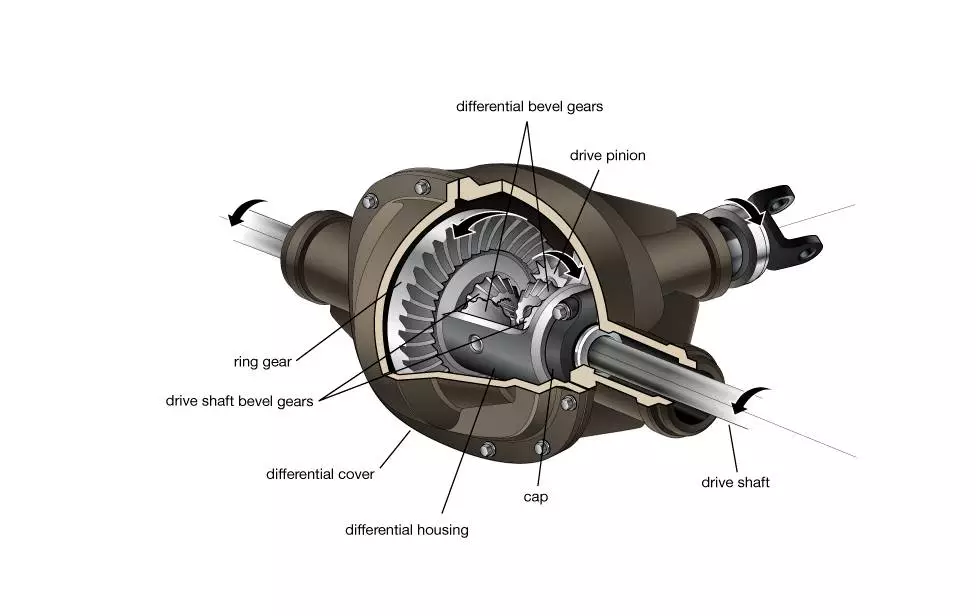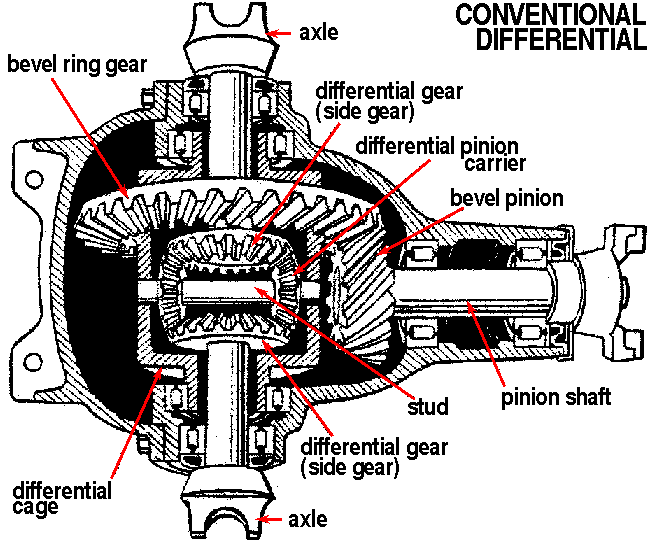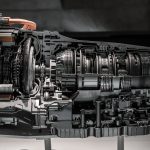
Differential System definition
A differential System is a system of gears that allows different drive wheels (the wheels to which power is delivered from the engine) on the same axle to rotate at different speeds, such as when the car is turning. A differential is also the component through which a rotating driveshaft can change direction; for example, in a rear-wheel-drive car whose driveshaft runs the length of the vehicle, it joins and transfers its power to an axle that runs perpendicular to the car to drive the left and right wheels. Differentials are low-maintenance, sealed components that are expected to last the vehicle’s life but may have a recommended service interval to check and replace the oil. Note that a car with four-wheel drive can have two or more differentials. A failing differential can cause vibration, binding during turns, and/or sounds ranging from clunking to howling.

An open end Differential System:
The simplest and most common unit is the open differential, called that because the wheels can always turn independently of each other. Its main drawback is that if one wheel doesn’t have traction, such as if it hits the ice, it still gets lots of power. It spins helplessly, and you go nowhere.
To help with traction loss while you’re driving, all new vehicles must be equipped with traction and electronic stability control. These use sensors from the anti-lock brakes to determine if one wheel is turning faster. It then reduces engine power or brakes the spinning wheel, or both, to get things under control.
Sometimes you want a wheel to spin, such as when trying to get out of deep snow, so traction control can be temporarily disabled with a button on the dash.
Limiting the slip:

Some vehicles, primarily performance models, use a limited-slip differential instead of an open one. If one wheel loses traction, power goes to the other wheel. This reduces wheel spin, and on a higher-powered FWD vehicle, helps prevent torque steer — the tendency for a front driver to pull from side to side when you step on the throttle.
Limited slips all serve the same purpose, but exactly how they do it depends on what type they are. A mechanical-clutch differential has clutch plates alongside the gears, and when needed, pressure rings press on the plates to provide resistance. An active differential system works the same way, but uses a computer to monitor the driving conditions and activate the differential’s clutch.
A viscous differential contains friction discs submerged in oil, and when a wheel slips, the fluid’s movement causes the discs to rotate at different speeds and send more power where needed. A Torsen differential — it’s a brand name, derived from Torque-Sensing — adds worm gears to the differential gear set to activate the necessary resistance.
A little boost around the bend
All differentials get you around the corner, but some do it better than others. A vehicle with torque vectoring sends a little more power to the outside wheel. This “pushes” the vehicle into the curve, and reduces understeer so the turn is tighter.
Some automakers provide an electronic torque-vectoring effect, using sensors to apply the brake on the inside wheel so the vehicle pivots around this slower-turning tire. In a true torque-vectoring system, the differential sends more power to the outside wheel. This improves handling but it’s also costlier, so it’s usually found primarily on pricier sports models.
Lockdown in the tough stuff
A locking differential lets the wheels turn at different speeds most of the time, but when its locking function is activated, the wheels both turn at the same speed. It’s primarily used for off-road driving. In addition to a rear-wheel locking differential, the toughest 4x4s will also have a locking front differential. A vehicle with one or both differentials locked can crawl forward over rocks or tough surfaces, but it’ll be very hard to turn.
Middle management
In addition to their front and rear differentials, AWD vehicles have a center differential that distributes power to whichever axle isn’t directly powered by the engine. That center differential may also be open, limited-slip, viscous, or Torsen.
Under normal driving conditions, many AWD vehicles send all the engine’s power to only one axle, usually the front one. If those wheels start to slip, the differential sends power to the other. Some vehicles send power to both axles all the time, although one generally gets more than the other. A few SUVs have a “lock” function that divides power 50/50 front-to-rear when activated, but only at low speeds to get you out of deep snow or mud, and the lock automatically turns off above a pre-set speed.
True 4WD systems power the rear wheels but have a transfer case that sends power to all four wheels when activated. If your truck or SUV only has ‘4LO’ and ‘4HI’ settings, both axles are turning at the same speed, and should only be driven on loose surfaces. On pavement, the system can bind. Some 4WD systems also have an “Auto” setting. This works like an all-wheel system, sending power to the front axle only as needed so the vehicle can be driven four-wheel on asphalt. Be sure you know what you have, and how you’ve set it, before you four-wheel.
For More Press Here









